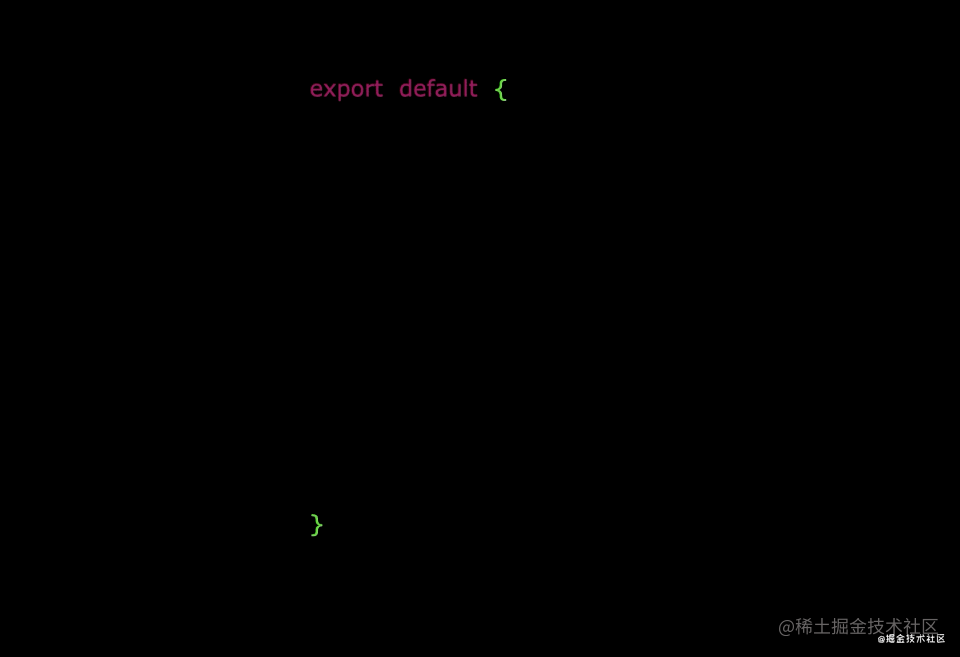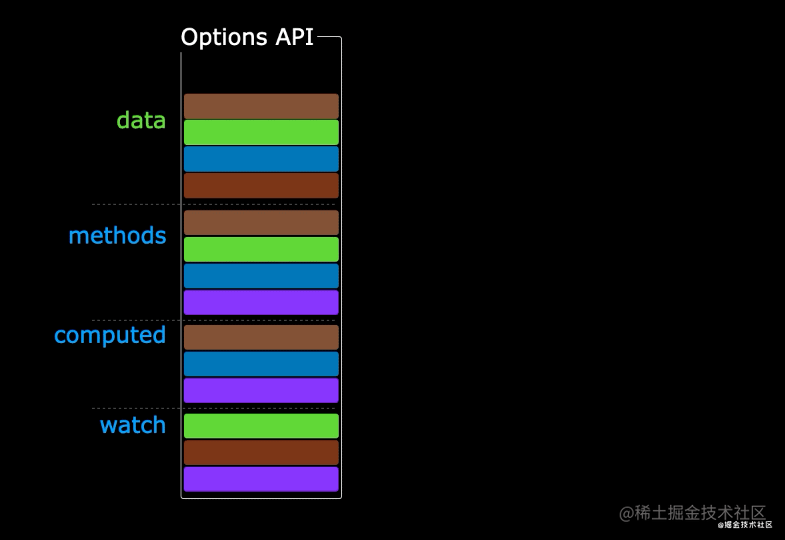Vue3
目录
一 vue3 介绍
1 Vue3的变化
1.1 性能的提升
- 打包大小减少41%
- 初次渲染快55%, 更新渲染快133%
- 内存减少54%
1.2 源码的升级
- 使用Proxy代替defineProperty实现响应式
- 重写虚拟DOM的实现和Tree-Shaking
1.3 拥抱TypeScript
- Vue3可以更好的支持TypeScript
1.4 新的特性
- Composition API(组合API)
- setup配置
- ref与reactive
- watch与watchEffect
- provide与inject
- 新的内置组件
- Fragment
- Teleport
- Suspense
- 其他改变
- 新的生命周期钩子
- data 选项应始终被声明为一个函数
2 组合式api和配置项api
-
组合式api
都写到一个函数中,定义变量和定义方法,定义计算属性都是放在一起,不是拆到不同地方了 -
配置项api:之前vue2中的写法
new Vue({
data:{
name:'lqz'
},
methods:{
# 使用变量
}
})


3 vue3 之vue实例
# vue3的app实例
也是个对象,但是以后我们使用东西,不是从this中拿了,this当没了
# vue2的app实例
就是咱们再组件中用的this
this.$store
this.$refs....
# 以后真正vue3的语法,写法可能变了
4 创建vue3 项目
4.1 使用 vue-cli 创建
官方文档:https://cli.vuejs.org/zh/guide/creating-a-project.html#vue-create
# vue3 完全兼容vue2
-vue create vue_cli_test
-路由选择,选择vue3即可
-跟之前创建vue2是一样的
4.2 使用 vite 创建
-vite:vue_vute_test
npm init vue@latest
按下图选择

- 工具链,构建工具
- 之前咱们再html中写,可能js可以引入
- 可能写了一些 es高版本的语法----> 转成低版本
- 可能写 xx.vue,浏览器识别不了,浏览器只能识别:html,css,js
- 咱们需要 有个东西可以一次性把 es高版本转成低版本,把xx.vue 转成xx.js的方式
- 工具链:
- webpack
- vite
5 setup
# setup是个函数,以后vue的代码,都写在这里面
1 里面可以定义变量
2 可以定义函数,可以定义匿名函数
3 如果想在templage中使用,必须return
4 如果要对变量加入响应式,需要使用ref包裹变量
5 data,methods都可以用,但是是setup函数先执行,才走其它
6 template中使用函数,变量,都优先用setup中的
7 setup最先执行,是再生命周期的beforeCreate前执行的,内部没有this,也不能用this了
6 响应式
6.1 ref函数
# 包裹变量,实现响应式
let name = ref('lqz')
<template>
<div class="home">
名字是:{{ name }},年龄是:{{ age }},爱好:{{ hobby }}
<br>
<button @click="handleAdd">点我涨年龄</button>
<br>
<button @click="handleChange">点击变名字</button>
</div>
</template>
<script>
// 导入ref函数
import {ref} from 'vue'
export default {
name: 'HomeView',
// 这样写支持
data() {
return {
// hobby: '篮球'
hobby: this.name + '爱打篮球'
}
},
methods: {
handleAdd() {
console.log('methods中的handleAdd')
}
},
// 以后我们写成这样,
setup() {
// 以后所有vue3的代码,都写在这里面
//原来写在data中定义变量
// 如果想在view中使用定义的变量,必须retur出去
// var:老语法 let:以后定义变量用这个 const :定义常量
// 1 定义变量,并再页面中渲染
// const name = 'lqz'
// const age = 19
// return {name,age}
// // return {name:name,age:age}
// 2 定义变量和函数,再页面中使用---->失去了响应式
// let name = 'lqz'
// let age = 19
// const handleAdd = () => {
// // alert('我被点了')
// // alert(add(4,5))
// age = age + 1
// console.log(age)
//
// }
//
// function add(a, b) {
// return a + b
// }
//
//
// return {name, age, handleAdd}
// 3 加入响应式
// let name = ref('lqz')
// let age = ref(19) // 他就变成了响应式
// const handleAdd = () => {
// console.log(age)
// console.log(typeof age)
// // age = age + 1
// // 以后需要用那个之,需要 对象.value才能取出来
// age.value = age.value + 1
// console.log(age)
//
// }
//
// const handleChange = () => {
// // name.value = '彭于晏'
// name.value = name.value+'nb'
// console.log(name)
// }
//
// return {name, age, handleAdd, handleChange}
// 4 研究一下,原来的data,methods还能不能用
let name = 'lqz'
let age = 19
// const handleAdd = () => {
// console.log('setup中的handleAdd')
// }
console.log('---',this)
return {name, age,}
}
}
</script>
6.2 reactive函数
### 使用方式
<template>
<div class="home">
<h1>首页</h1>
<!-- 名字是:{{ name.value }}-->
名字是:{{ data.name }}---->年龄:{{ data.age }}
<button @click="handelAdd">点我加年龄</button>
</div>
</template>
<script>
import {ref, reactive} from 'vue'
export default {
name: 'HomeView',
setup() {
// 1 要让变量有响应式,要用ref包裹一下,包裹的都是字符串,数字,布尔
// js中再使用这个变量取值赋值是要 变量名.vaule 使用
// template中使用变量不要用.value
// let name = ref('lqz')
// name.value = '彭于晏'
// return {name}
// 2 如果想让对象有响应式,reactive
let data = reactive({'name': 'lqz', 'age': 19, 'hobby': '篮球'})
const handelAdd = () => {
data.age += 1 // 使用reactive包裹的对象,直接当对象用即可
console.log(data)
}
return {data, handelAdd}
}
}
</script>
7 reactive与ref对比
-
从定义数据角度对比:
- ref用来定义:基本类型数据
- reactive用来定义:对象(或数组)类型数据
-
从原理角度对比:
- ref通过Object.defineProperty()的get与set来实现响应式(数据劫持)。
- reactive通过使用Proxy来实现响应式(数据劫持), 并通过Reflect操作源对象内部的数据。
-
从使用角度对比:
- ref定义的数据:操作数据需要.value,读取数据时模板中直接读取不需要.value。
- reactive定义的数据:操作数据与读取数据:均不需要.value。
8 计算,监听属性
8.1 监听属性
### 监听属性 就是使用watch,三种方式
# 导入
import {watch} from "vue";
# 1 方式一
watch(name, (newValue, oldValue) =>{
console.log(newValue)
console.log(oldValue)
console.log('name 真的变了...')
})
# 2 监听属性之监听对象中的某个属性
let person = reactive({name: 'lqz', age: 19})
watch(() => person.name, () => {
console.log('person中的name变了')
})
const handleChanel = () => {
person.name = '刘亦菲'
}
# 3 同时监听多个变量
# 3.1 监听两个变量
const sum = ref(100)
const msg = ref('很好')
watch([sum, msg], (newValue, oldValue) => {
console.log('sum或msg变化了', newValue, oldValue)
})
# 3.2 监听变量和对象
watch([age, () => info.username], (newValue, oldValue) => {
console.log('年龄或对象中的用户名变化了', newValue, oldValue)
})
8.2 计算属性
- 计算属性 使用computed ,只有取值触发或取值赋值触发函数
<template>
<div class="home">
<h1>首页</h1>
<input type="text" v-model="name"> ---> {{ newName }}
<br>
<input type="text" v-model="newName2">
</div>
</template>
<script>
import {ref, reactive} from "vue";
import {computed} from "vue";
export default {
name: 'HomeView',
setup() {
let name = ref('')
// 1 计算属性取值
let newName = computed(() => {
return name.value + 'nb'
})
// 2 了解:计算属性可以取值用,还可以改值
let newName2 = computed({
get() {
// 使用计算属性,会触发这里
return name.value + '=nb'
},
set(value) {
// 只要计算属性发生变化,就会执行这里
console.log('计算属性变了,变成', value)
// 只要newName变了,name理应该也变,需要我们写代码变
let res = value.split('=')
name.value = res[0]
}
})
return {name, newName, newName2}
},
}
</script>
9 生命周期
# 8 个生命周期钩子
# vue3不建议使用 配置项api,把所有代码都写在setup函数中
-以后没有:destory这俩了,换成了unmounted
-可以写配置项api(练习一下)但是不建议写了
beforeCreate
created
beforeMoun
mounted
beforeUpdate
updated
beforeUnmount
unmounted
-写组合式api
beforeCreate===>setup()
created=======>setup()
beforeMount ===>onBeforeMount
mounted=======>onMounted
beforeUpdate===>onBeforeUpdate
updated =======>onUpdated
beforeUnmount ==>onBeforeUnmount
unmounted =====>onUnmounted
组件的生命周期钩子vue2使用
export default {
// 生命周期
// beforeCreate
// created
// beforeMount
// mounted
// beforeUpdate
// updated
// beforeUnmount
// unmounted
created() {
console.log('创建了')
},
beforeUnmount() {
console.log('beforeUnmount')
},
unmounted() {
console.log('unmounted')
},
}
vue3使用生命周期钩子
HomeView.vue
<template>
<div class="home">
<h1>首页</h1>
<button @click="handleShow">点我显示</button>
<HelloWorld v-if="show"></HelloWorld>
</div>
</template>
<script>
import {ref} from "vue";
import HelloWorld from "@/components/HelloWorld";
export default {
name: 'HomeView',
setup() {
let show = ref(true)
const handleShow = () => {
show.value = !show.value
}
return {show, handleShow}
},
components: {
HelloWorld
}
}
</script>
HelloWorld.vue
<template>
<div class="hello">
<h1>HelloWorld页面</h1>
</div>
</template>
<script>
import {ref} from "vue";
import {onBeforeMount, onMounted, onBeforeUpdate, onUpdated, onBeforeUnmount, onUnmounted, reactive} from 'vue'
export default {
name: 'HelloWorld',
setup() {
// 生命周期钩子
// beforeCreate===>setup()
// created=======>setup()
// beforeMount ===>onBeforeMount
// mounted=======>onMounted
// beforeUpdate===>onBeforeUpdate
// updated =======>onUpdated
// beforeUnmount ==>onBeforeUnmount
// unmounted =====>onUnmounted
console.log('vue组件创建了(包含beforeCreate,created)')
// 1 如果想组件创建完成,就发送ajax请求,直接写在setup里面即可
// let name = ref('')
// axios.get('地址').then(res => {
// name.value = res.data.name
// })
// 2 原来写在created中的,直接写在下面即可,直接在这开启定时器
var t = setInterval(() => {
console.log('hello world')
}, 1000)
onBeforeUnmount(() => {
console.log('onBeforeUnmount')
// 消除定时器
clearInterval(t)
t = null
})
onUnmounted(() => {
console.log('onUnmounted')
})
},
}
</script>
10 toRef
# ...{对象} ---> 相当于解压
# 再setup函数中return时,使用return {...toRefs(data)},以后再templte中直接使用内层的变量即可
setup() {
let a = {hobby: '篮球', gender: '男'}
console.log(a)
let b = {...a, name: 'lqz'}
console.log(b)
},
基本使用
<template>
<div class="home">
<h1>首页</h1>
{{ name }} --- {{ age }}
<br>
<button @click="handleClick">点我看美女</button>
<br>
<button @click="handleAdd">点我改年龄</button>
</div>
</template>
<script>
import {ref, reactive, toRefs} from "vue";
export default {
name: 'HomeView',
setup() {
let data = reactive({name: 'lqz', age: 19})
const handleClick = () => {
alert('美女')
}
const handleAdd = () => {
data.age += 1
}
// ...toRefs(data) 等同于 {name:data.name,age:data.age}
// return {name: data.name, age: data.age, handleClick}
return {...toRefs(data), handleClick, handleAdd}
},
}
</script>
二 Vite创建项目
官方文档:https://v3.cn.vuejs.org/guide/installation.html#vite
vite官网:https://vitejs.cn
介绍:https://cn.vitejs.dev/guide/why.html#the-problems
- 什么是vite?—— 新一代前端构建工具。
- 优势如下:
- 开发环境中,无需打包操作,可快速的冷启动。
- 轻量快速的热重载(HMR)。
- 真正的按需编译,不再等待整个应用编译完成。
传统构建 与 vite构建对比图
# 确保你安装了最新版本的 Node.js,然后在命令行中运行以下命令
cnpm init vue@latest

# 安装依赖
cnpm install
# 运行
cnpm run dev
2.1 vue3 setup写法
<script setup>
// <script setup> 表示,这个script里的所有东西是setup函数,原来写在setup中的,现在顶格写即可
import {ref, reactive} from "vue";
let name = ref('lqz')
const handelClick = () => {
name.value = '彭于晏'
}
// 不需要return,直接使用即可
let info = reactive({hobby: ['篮球'], addr: '上海'})
const handleInfo = () => {
info.hobby.push('足球')
}
// watch,computed
// 生命周期钩子
// 组件导入,自动注册
import HelloWorld from "@/components/HelloWorld.vue";
</script>
<template>
<h1>我是首页</h1>
{{ name }}
<br>
<button @click="handelClick">点我变名字</button>
<h1>对象</h1>
{{ info.hobby }} --- {{ info.addr }}
<br>
<button @click="handleInfo">点我加爱好</button>
<h1>使用组件</h1>
<HelloWorld msg="HelloWorld"></HelloWorld>
</template>



